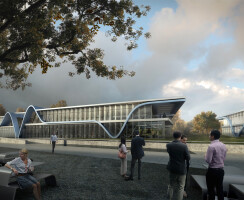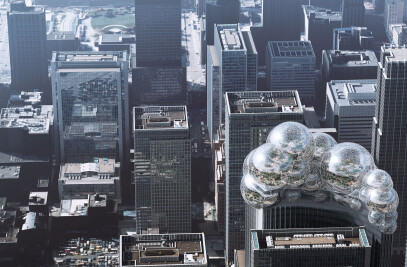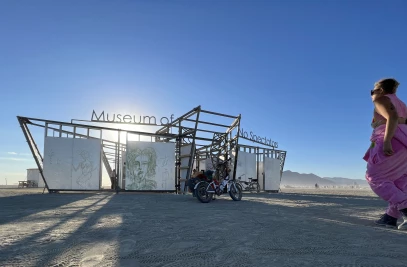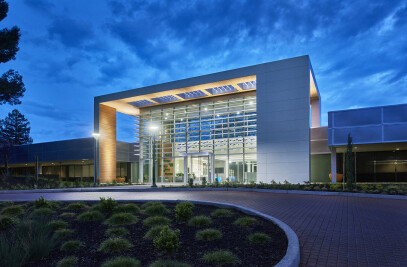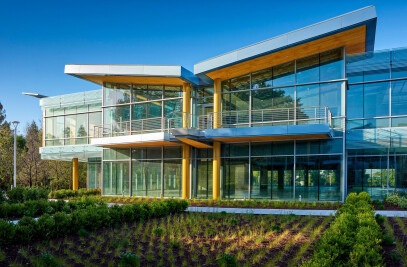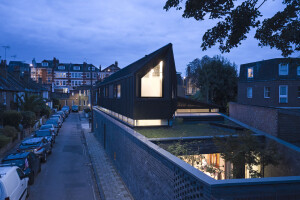23-Aug-2014 The Innovation Curve proposes a new workplace that is flexible, open and uses a dominant design element to celebrate the innovation process that is so often associated with its geographical location of Silicon Valley. Designed in 2013 the 285,000 square-foot proposed project rises on a hotspot in the golden geography of the bits economy. Located on the edge of Stanford Research Park, the site sits directly across the street from the Hewlett Packard Headquarters. The existing site consists of an L-shaped lot with unsightly parking on grade serving two existing buildings, a typical specimen of the architectural generic that has marred what once was a luscious apricot grove. Deemed inimical to future growth for the sought-after tenants, these obsolete structures are slated for demolition. But their previous occupants are just as legendary as their immediate neighbors: the two bar-shaped buildings housed the most recent headquarters of the giant company Facebook.
The proposed design recognizes and celebrates the essence of the research park: an innovative entrepreneurial spirit. If being an entrepreneur equates to being an individual, the architectural containers hosting these teams flirting with our shared tomorrow lend themselves to become built-up manifestation of the mindset of the people inhabiting it. This design de facto gives material form to a creative tension grounded in the ruthless reality of economically viable implementation. The sensuous mid-level blue horizontal ribbon shading element follows the shape of the classic R&D timeline; from creative spark, though trial and tribulation, to welcome success. The highs and lows of an idea within reach, yet to be perfected and fine-tuned, form the discreet points of a curve, metaphorically bearing anticipation and anxiety. For this scheme, the innovation diagram is generative of the compound's urban appearance as well as its internal parti. To further activate the space, terraces break down the scale of the building along the inner campus to create places for people to work or meet. In erecting a billboard of the innovation rollercoaster, the community is reminded of the peaks and valley of effervescent thinking characteristic of the process of change.
Ever conscious of the importance of sustainability, the envelope shading strategy, conceived in a lyrical way, takes on a form evocative of this entrepreneurial spirit. The clear glass envelope with glass shading fins creates a crystalline form that evokes a sense of lightness and spirit. In an effort to let the energy model allow more exterior glass, deep horizontal sunshades are present throughout the buildings. Translucent glass fin verticals and a deep roof overhang complete the shading strategy. The building will achieve a LEED Platinum rating, and thru the use of photo voltaics will also achieve a Net Zero rating.
The normative Silicon Valley Tech campus is closed to the public. The Innovation Curve breaks with this tradition by reaching out to Page Mill road. A broad sweeping entry, drive and pedestrian way welcoming the public into a vast inner courtyard garden.
In making the innovation diagram the face of the buildings, users and visitors inhabit symbolically a space of and for innovation, for expansive and intense focus. It is at the building's entry point, however, where the spatial experience reaches its apex. The lyrical metaphor yields maximum effect onto the users at the threshold. The valley of this innovation vessel gives a magnetic material form to the intoxicating excitement of what is yet to come. Tomorrow is already here.
19-Aug-2016 ‘The Creative Process Made Visible’ at Innovation Curve Technology Park Dynamic Tech Headquarters by Form4 Architecture Breaks Ground in Silicon Valley The dynamic architecture of the Innovation Curve Technology Park at Stanford Research Park celebrates the creative process of invention. The peaks and valleys of sweeping metal curves serve as architectural metaphors for the highs and lows of exploratory research and development. Located on the edge of Stanford Research Park in Palo Alto, the site will become an uplifting campus for tenants involved with computer gaming, translation software, and digital inventions. The project—designed to earn a LEED-Platinum rating—is currently under construction, with anticipated completion in 2017.
Designed by Form4 Architecture of San Francisco, the new 13.5-acre Palo Alto campus developed by Sand Hill Property Company comprises four buildings, totaling 265,895 square feet. Representing the diagram of innovation on the face of the buildings, the lyrical design serves as a potent visual reminder of the dedicated, expansive, and intense work taking place inside. “The Innovation Curve is a billboard of effervescent thinking characteristic of the entrepreneurial spirit of Silicon Valley,” says John Marx, AIA, design principal at Form4 Architecture.
In addition to Innovation Curve, Form4 has designed expressive headquarters and interiors for Netflix, VMware, Workday, and DayNine, as well as several office buildings intended for a variety of innovative tech companies. “We have been on the forefront of an evolution from Silicon Valley’s utilitarian/manufacturing roots toward an architecture of increased intellectual creativity and worker vitality that stimulates community engagement,” notes Marx. The Innovation Curve is one of several Form4 designs currently featured at the “Time-Space-Existence” exhibition in conjunction with the 2016 Venice Architecture Biennale.
The Innovation Curve buildings are arranged around a central landscaped courtyard with diagonal pedestrian paths leading from adjacent streets through the site. Each 35-foot-tall structure comprises two offset wings flanking a central, glass-faced lobby to break up the building mass. In the lobby, both the concrete courtyard paving and metal curves of the building exterior extend through the two-story space to create a sculptural portal connected to the outdoors.
On the building exteriors, projecting roofs and deep overhangs—to be fabricated of painted recycled aluminum—are configured to express the roller-coaster evolution of innovation. The tall, two-story curves rise to represent the crescendo of the creative spark and pragmatic analysis of ideas, and descend to transition into long, horizontal bands symbolizing the implementation phase of invention. The architecture of the new research park captures the forward-leaning spirit of technology in metal and glass, evoking machined precision, transparency, and modernity. “The process of creativity is made visible in three dimensions,” says Robert J. Giannini, president of Form 4 Architecture.
The overhangs curving downward to low points near the ground capture the challenging process of risk assessment, market financing, and decision-making. From there, they rise to the ends of each building to express an uplifting conclusion to the innovation diagram. These projecting planes supply outdoor balconies offering vistas of the campus and the bits and bytes world outside the technology park.
In addition to their symbolic significance, the deep overhangs work in combination with vertical glass fins to shade the building exteriors, control solar heat gain, and allow for greater transparency and connection to campus life. To allow for more exterior glass, deep horizontal sunshades, which also act as light shelves, extend from perimeter walls. Solar-controlled skylights augment the daylighting scheme to reduce the need for artificial illumination. Aiming to achieve LEED-Platinum certification, the building incorporates additional sustainable elements, such as automated shade infrastructure, high-efficiency mechanical and electrical systems, high-performance cool roofs, solar photovoltaic power generation, recycling of construction waste, locally sourced materials, and bioswales landscaped with native plants. The sustainable features contribute to significant increase in thermal comfort for the occupants, which results in higher occupant satisfaction and productivity, as well as a gentle wear on mechanical systems.
Form4 Architecture believes architecture is the art of giving form to ideas. The award-winning firm specializes in creating environments, whether for tech offices mixed-use developments, or residences, that respond as equally to the topography of a site as they do to the people they serve. Form4 creates formal expressions that are not only poetically moving and conceptually thoughtful, but also reflective of the client’s values and goals. As collaborative partners in the design process, the principals of Form4 Architecture—Robert J. Giannini, John Marx, AIA, Paul Ferro, AIA, and James Tefend, AIA—are personally involved with every project from concept to completion, bringing the collective wealth of years of expertise and knowledge to each client's vision. Since 1999, the firm has built a rich portfolio of award-winning work for national and international clients within diverse market sectors.





